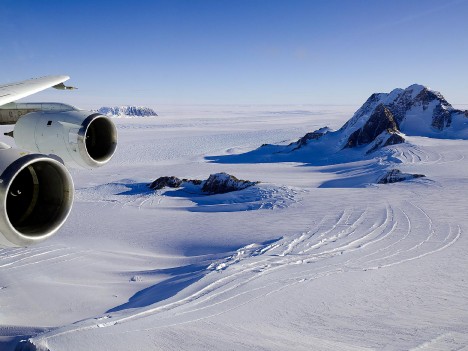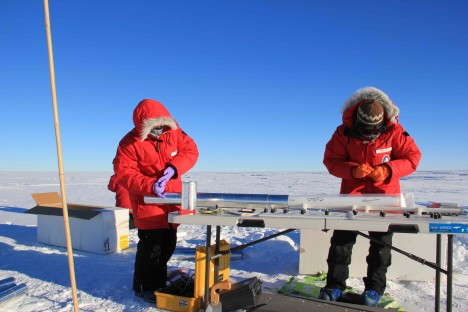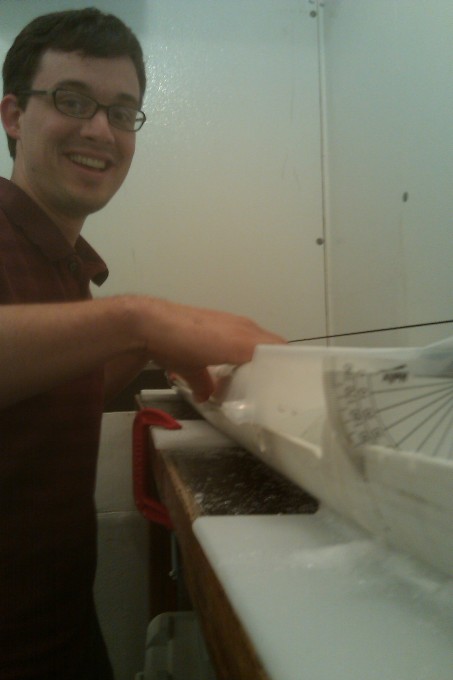By Lora Koenig
Two weeks ago, I traveled to Utah to help the team finalize planning for this season and to visit the ice core lab and our 2010 ice cores at BYU. The entire was there, except for Ludo, who was in Hawaii competing in a triathlon. (Ludo is not only a top scientist but a top triathlete. I hope he is not getting too use to the warm weather because in less than a month he will be facing temperatures around 0°F.)
There were a few tasks to complete in Utah. The first was to look at many different types of satellite data on the region where we will be traveling to make sure there aren’t any crevasses or other dangers along the route. A crevasse is a crack in the ice. As the ice flows (yes, ice flows just like a mound of putty), it can crack when it goes over a bump or accelerates. Here is a recent picture of crevasses in Western Antarctica, from a NASA Operation IceBridge flight.

As you can imagine, we would not want to drive a snowmobile in an area like this. So we spent hours looking over maps of the rock bed under the ice sheet to look for bumps, visible and radar satellite images of the surface of the ice sheet, and satellite data showing the velocity of ice flow to make sure that we are traveling on the safest possible route. We ended up moving one ice core drilling location slightly to avoid a dark spot that we could not clearly identify in one of the radar images, just to be extra cautious. Once the route was established, we generated waypoints (coordinates) every kilometer to load into the GPS units that we will use for navigation. The place we are going to is big, white and flat: It is very easy to lose your sense of direction, so we rely heavily on GPS units for navigation.
For some great images and videos on how ice flows in Antarctica please check out this video, made by our NASA colleague Eric Rignot who (thanks again, Eric!) also checked the data that sits behind these videos to help ensure our safe route.
If you would like an in-depth look, this file, which opens on Google Earth, shows our final route with points every 1 km.
Our second task in Utah was to visit last year’s ice cores and have our first meeting to discuss the initial data coming from them. First, here is a picture of a core in the field, taken in December 2010.
In this photo, Michelle (right) is labeling the core and I (left) am getting the core tube ready for storage. The arrow on the ice core bag shows which direction is up. It is very important that all the cores are labeled in order, or we would lose our time series. The metallic tube in the center left of the picture protects the core during shipping. The core in the tube gets placed in the white core box sitting open on the left side of the picture. (Also, notice that Michelle is standing on a bright green pad to help insulate her feet from the cold snow. It’s a veteran trick for keeping your toes warm.)
Here is that same core in the lab today.
Summer is holding what was about 8 feet of the core and the rest of the about 50 feet of core is stacked in the boxes behind her, waiting for analysis.
Here is a very basic explanation of what happens to the cores once they arrive at Summer’s lab at BYU. (Normally, Summer would be the one writing this, but she is currently studying glaciers in Bhutan.)
When the core arrives, we put it in the freezer. Here is Landon peering out of the freezer door:
In the freezer, we weigh the core to determine its density and measure its electrical conductivity, which tells us about its chemical composition. A volcanic event would be detected in the cores by the electrical conductivity and can be used to set a point in time. We take all these measurements twice, or even three times, to make sure they are accurate.
Here is a picture of a core that Landon is preparing, sitting on the freezer’s core handling tray:
This freezer is set to -4°F, so when not posing for a picture, Landon would normally be in a parka with gloves on. As you can see, the core is still in its protective bag, which will be removed when actually processing the core. From here, the core is cut up into sections less than an inch (2 cm) long, and melted for the next stage of analysis.
I will add a quick note here that on last year’s traverse Landon was our lead driller. Both Landon and Jessica are masters students at BYU. They are not only integral players of the field teams, but are also the lead students for the lab analysis of these cores.
Once we have melted the core and put it in a bottle, we send it over to Jessica.
Here is Jessica operating the mass spectrometer (black box to the left in the picture with the blue screen) that will measure the stable water isotopes used to date the core. The isotopes in the snow have an annual cycle and it is this cycle that determines age of the core. An isotope is an atom, in our case an oxygen atom, that has different variations with different number of neutrons and atomic numbers. Oxygen has three stable isotopes: 16O, 17O, and 18O. The peaks and valleys in the ratios of 18O/16O reflect the warmer (summer) and cooler (winter) temperatures, respectively. Once the mass spectrometer determines the number of isotopes, we can establish the age of the core, in a way similar to counting tree rings. During this process, the core is in the little blue vials just to the right of Jessica.
After spending some time in the lab, we looked at the data from the first core that has been analyzed. At this point the density and isotopes have been measured and Summer is carefully working to put together the depth-age scale, which is the age of the core at each depth where the core use to sit in the ice sheet. I will use the density data from the core to determine an age-depth scale from the layers in the radar data and if all goes well the radar and ice core will line up giving us confidence in our analysis.
Last Monday, when I returned to Goddard, I had received my travel itinerary. We will be leaving the U.S. on Nov 17th to make our journey down to Antarctica. With all of this preparation, I am eagerly awaiting getting my feet on the Ice.
Tags: Antarctica, crevasse, glacier, GPS, ice, ice core, NASA, SEAT, snow, traverse









as a retired london- city-insurance worker, i am still ever curious about many things.
NASA are doing a fantastic job giving the world vital information regarding the arctic and antarctic regions. so that unconnected (to science) people can begin to understand such an important part of our world in such a practical way which is absolutely up to date i.e. 2011, when the original explorers only 100 years ago were
traversing this area for the very first time with such primative equipment and clothing.
we are priviliged to be able to tap in to the latest information almost as it happens.
thank you NASA and all the young operatives who make this possible. well done for a splendid achievement to all concerned.
thank you again. peter willig. east sussex. england.
Hello Lara,
I hope you will excuse me asking, but how is the ice transported from Antarctica? Does it travel by ship or air?
I am writing a comedy film about the PR wars around global warming called “Chicken Licken was right” My hero is a climate scientist trying to warn the world about AGW but coming up against the well-funded oil industry. I wondered if it was possible for him to have lost some ice samples at an airport. It’s okay if they’re not normally transported in the hold of a plane, but it would be useful for my plot if some could be! Perhaps it’s a small sample he wants to show his students.
Good luck with your trip and thank you for your work in this area. I’m really concerned about climate change but writing a comedy because I agree with Billy Wilder who said “If you’re gonna tell people the truth, make ’em laugh or they will kill you.”
Helen Bang, Bonnybridge, Scotland
PS, apologies, Lora, I misread your name.
Hi Helen,
Our ice cores are flown out of the field in Antarctica to McMurdo Station on what we call a “cold deck” flights (a flight where the heat has been turned off in the plane, so the cores can stay cold.) In McMurdo, the cores are kept in a freezer that is always below -20 C. They are then loaded into a freezer on a boat that arrives brings the cores to California. In California they are transferred to freezer trucks that carry them to the freezers at Brigham Young University. Quite a long trip for these important records of past climate!
Lora Koenig
Thanks very much. Good luck with your trip.
Helen